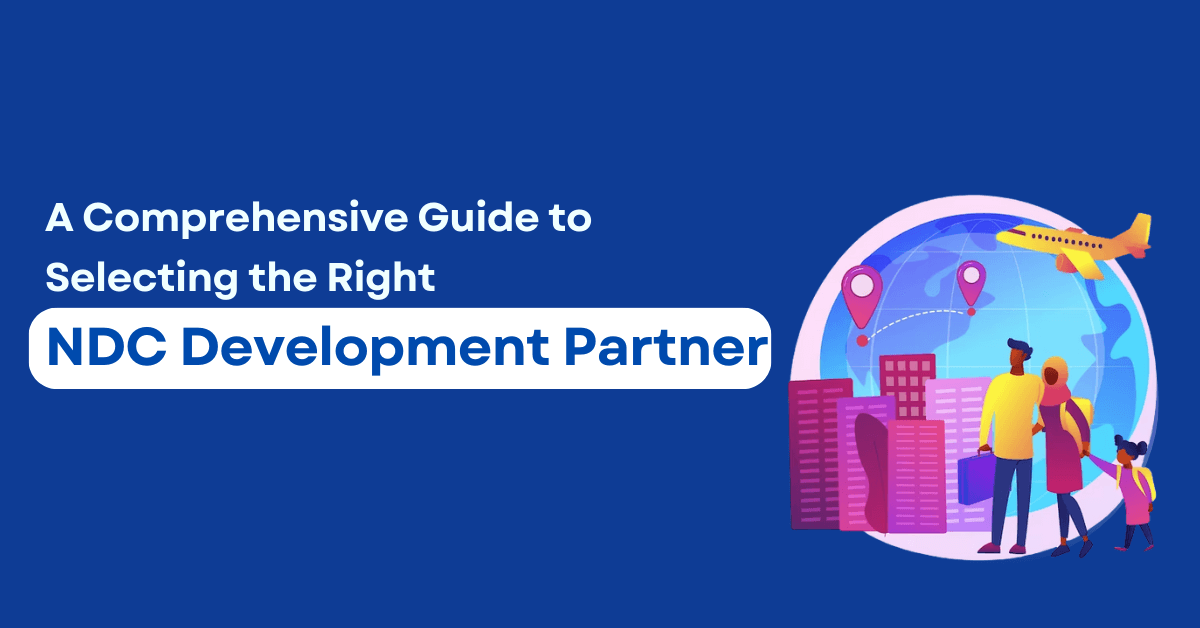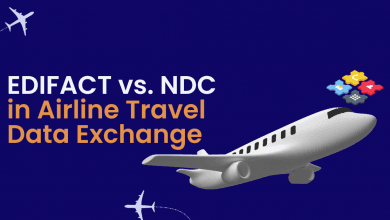A Comprehensive Guide to Selecting the Right NDC Development Partner

NDC, an acronym for New Distribution Capability, represents a travel industry initiative introduced by IATA (International Air Transport Association). Its core purpose revolves around the development and widespread adoption of a novel data transmission standard, founded on XML technology. This initiative emerged as a replacement for the antiquated EDIFACT system, which had been the industry standard for an extensive period.
The fundamental objective of NDC is to revolutionize and standardize the distribution and sales processes for air travel products. This transformation is driven by the ambition to deliver an enriched, more personalized shopping experience to consumers. NDC achieves this by empowering airlines to distribute their complete range of offerings directly to both travel agents and consumers. In doing so, it circumvents the constraints imposed by legacy systems. This comprehensive offering extends beyond conventional elements like fares and schedules, encompassing ancillary products and services such as baggage fees, in-flight dining options, and seat preferences.
Major Stakeholders
The NDC initiative involves several key stakeholders, each playing a distinct role:
Airlines
Positioned at the forefront of this transformation, airlines constitute the core driving force behind NDC. NDC equips the airlines to present a more extensive and finely-tailored array of products and services to their clientele, thereby enhancing the customer experience.
Travel Agents
NDC extends its benefits to travel agents, enabling them to offer a more all-encompassing and personalized service suite to their customers. This newfound capability supplies travel agents with the tools needed to meet the evolving demands of modern travelers.
IATA (International Air Transport Association)
As the authoritative organization overseeing the NDC standard, IATA assumes the pivotal role of facilitating the standard’s development, widespread adoption, and continuous evolution. IATA serves as the central authority ensuring the seamless functioning of the NDC ecosystem.
Technology Providers
These are entities specializing in the development of software solutions that underpin the operational framework of NDC. They create the technological infrastructure that serves as the connective tissue between airlines and travel agents, enabling the exchange of rich data and content.
Consumers
Lastly, the ultimate beneficiaries of the NDC initiative are the travelers themselves. NDC endeavors to provide travelers with a more personalized, transparent, and fulfilling shopping experience. It equips them with a wealth of options and information to make informed choices, ultimately enhancing their overall journey.

Market Challenges and NDC’s Solutions
Industry Challenges
The aviation sector has grappled with persistent challenges stemming from obsolete technologies and distribution approaches. These antiquated systems have imposed limitations on airlines, hindering their capacity to distinguish their offerings effectively. Simultaneously, they have constrained the methods through which travel agents could market and sell airline products. Consequently, the industry often found itself characterized by a commoditized market dynamic, with price emerging as the sole decisive factor in consumers’ decision-making processes.
NDC’s Strategic Objectives
The New Distribution Capability (NDC) was conceived to address several critical predicaments prevalent in the airline industry:
Limited Product Differentiation
NDC is engineered to empower airlines to provide a more personalized and distinct array of products and services. By doing so, it aims to enhance customer satisfaction levels and, subsequently, bolster airlines’ revenue streams.
Lack of Price Transparency
NDC aspires to introduce transparency into pricing structures. It facilitates customers in comprehending the comprehensive cost of their travel itinerary upfront, eliminating hidden fees and charges that might obscure the true expense of their journey.
Outdated Distribution Methods
NDC’s ultimate goal is to revolutionize airline distribution channels. It offers a more efficient, cost-effective, and technologically advanced alternative to the traditional Global Distribution Systems (GDS), thereby streamlining operations across the industry.
NDC Key Features for Airlines
The New Distribution Capability (NDC) offers airlines a range of distinctive features that significantly enhance their operations:
Enhanced Communication
NDC excels in facilitating advanced communication between airlines and travel agents. Its XML-based framework surpasses traditional systems by enabling the exchange of a more extensive dataset. Airlines can now share not only fare information but also details regarding ancillary services, seat availability, and more, providing a comprehensive overview of travel options.
Personalization
NDC empowers airlines to deliver highly personalized services to their customers. Whether it involves selecting specific seats with added legroom, pre-ordering in-flight meals, or choosing additional baggage options, airlines can package and present these services with remarkable efficiency. This level of customization was previously challenging to achieve using older systems, which were ill-equipped to handle the intricate data associated with these supplementary services.
Direct Distribution
NDC grants airlines the ability to directly distribute their tickets and services to travel agents, bypassing intermediaries such as Global Distribution Systems (GDS). This not only leads to reduced distribution costs but also provides airlines with greater autonomy in how they present their products. Airlines can optimize their inventory management and launch real-time promotions or special offers.
Real-time Updates
In an industry characterized by rapid fluctuations in prices and availability, real-time updates are paramount. NDC empowers airlines to make instantaneous updates to fares, availability, and other service options. This ensures that customers continually access the most up-to-date information, ultimately enhancing their overall experience and satisfaction.
By enabling enriched communication, extensive customization, direct distribution, and real-time updates, NDC empowers airlines to adapt to the evolving demands of modern travelers. With these capabilities at their disposal, airlines can better serve their customers, streamline their operations, and remain competitive in an ever-changing industry.
EDIFACT: An Overview of Legacy System Architecture
EDIFACT, an acronym for “Electronic Data Interchange for Administration, Commerce, and Transport,” represents an international standard for Electronic Data Interchange (EDI). Initially developed under the auspices of the United Nations, Edifact has held a prominent position since the late 1980s. This well-established framework serves as one of the earliest methods for structured data exchange between organizations, including its extensive use in the airline industry. Notably, it has played a pivotal role in tasks such as ticket booking, scheduling, and various administrative functions.
Recognizing EDIFACT’s Limitations
Despite its longstanding presence and contributions, Edifact encounters several limitations within the contemporary context:
1. Limited Data Fields: Edifact’s origins are rooted in a simpler era, leading to constraints in its capacity to manage and process modern data requirements.
2. Lack of Customization: EDIFACT lacks the inherent flexibility to readily accommodate customized offerings or the inclusion of ancillary services, posing a substantial challenge in the current landscape of personalized marketing.
3. Complexity: Regarded as intricate and burdensome to both implement and maintain, EDIFACT demands specialized expertise for effective operation.
4. Inflexibility: EDIFACT exhibits reduced adaptability to incorporate real-time data modifications, a critical necessity in today’s fast-paced operational environment.
Contrasting with NDC
In contrast to NDC (New Distribution Capability), EDIFACT falls short in several pivotal aspects:
1. Data Richness: NDC, founded on XML technology, excels in handling a significantly broader spectrum of data, enabling the provision of more intricate and dynamic offers.
2. Real-time Updates: NDC facilitates real-time updates encompassing fares, schedules, and availability—an accomplishment that proves challenging with EDIFACT.
3. Customization: NDC empowers airlines to furnish passengers with a tailored shopping experience, encompassing bundled offers and ancillary services achievements that remain elusive within the constraints of EDIFACT.
4. Simpler Implementation: NDC generally offers a more streamlined implementation process, facilitating integration into existing systems and presenting a straightforward route toward modernization.
While EDIFACT remains a widely accepted standard for electronic data interchange, its practicality has been impeded by contemporary limitations. In this context, NDC demonstrates clear advantages, including real-time data exchange capabilities and the capacity to deliver more personalized products and services.
Post NDC implementation Architecture – NDC XML
NDC (New Distribution Capability) relies on XML (eXtensible Markup Language) as its underlying technology for data exchange. Unlike older formats like Edifact, XML offers a structured and standardized means of conveying intricate information between airlines and travel agents. This modernization facilitates a dynamic and real-time information exchange encompassing fares, schedules, and additional services.
NDC’s Scalability Advantage
One of the primary merits of employing XML in NDC lies in its scalability. As airlines broaden their service horizons and diversify their offerings, the NDC XML architecture adapts seamlessly to these developments, bypassing the need for extensive system overhauls. This scalability empowers airlines to pursue growth and innovation without technological limitations.
Tailoring Data Exchange and Customization
NDC’s XML-based framework introduces remarkable flexibility, especially concerning data exchange and customization. Airlines can now extend a more personalized experience to their passengers by presenting tailored fares, bundled services, and even dynamic pricing. Achieving this level of customization posed significant challenges within the confines of older, more rigid data exchange standards. Additionally, travel agents gain easier access to this enriched content, enabling them to enhance their service delivery to end customers.
Data Enrichment: Amplifying Data Sets
The utilization of XML within NDC also facilitates data enrichment by accommodating an array of attributes and elements within data sets. This enriched data encompasses multimedia elements such as images or videos, comprehensive service descriptions, and even real-time updates. These extensive data sets provide a more holistic view of the offerings, thereby augmenting the decision-making process for both travel agents and end customers.
NDC XML architecture offers numerous advantages compared to conventional GDS systems, notably in terms of scalability, flexibility, and data enrichment. By adopting XML for data interchange, NDC establishes a standardized pathway for exchanging data across different systems, simultaneously permitting enhanced customization and more comprehensive data sets.
Integrating into legacy CRS and PSS
Challenges During Integration
1. Data Compatibility: Integrating New Distribution Capability (NDC) with legacy Central Reservation Systems (CRS) and Passenger Service Systems (PSS) presents the challenge of data compatibility. Often, these legacy systems utilize outdated data formats that may not seamlessly align with NDC’s XML-based architecture. This misalignment can hinder the smooth flow of information between systems.
2. System Downtime: The integration process may necessitate system downtime, which can disrupt ongoing airline operations. During this downtime, services like booking and ticketing may be temporarily unavailable, potentially resulting in financial losses and inconveniences for both the airline and its customers.
3. Pricing: The financial investment required for successful integration can be substantial, especially for smaller airlines with limited budgets. Expenses may include software and infrastructure upgrades, training costs, and potential consulting fees. This financial burden can pose a significant challenge.
4. Technical Expertise: Integrating NDC into legacy systems demands technical expertise. Many airlines may lack in-house experts capable of navigating the complexities of this process. The absence of such expertise can lead to errors, delays, and additional costs during integration.
5. Change Management: Successful integration relies on the cooperation of employees and stakeholders. Resistance to change can make it challenging to implement new systems and processes effectively. Overcoming this resistance and ensuring a smooth transition is a vital aspect of integration.
Solutions for Smooth Integration
1. Data Mapping: To address data compatibility issues, airlines can employ middleware solutions that act as intermediaries. These middleware systems translate legacy data formats into NDC’s XML schema, facilitating seamless data exchange between systems. This ensures that critical information flows without disruption.
2. Phased Implementation: Airlines can adopt a phased approach to integration. This strategy minimizes system downtime by introducing NDC’s capabilities incrementally. Each phase is thoroughly tested before moving on to the next, reducing the risk of operational disruptions.
3. Budget Planning: Allocating a dedicated budget for integration is essential. Airlines should carefully assess the financial resources required and plan accordingly. Exploring opportunities for external funding or partnerships can help offset integration costs, particularly for smaller carriers.
4. Training and Skill Development: To overcome the lack of technical expertise, airlines can invest in training programs for their in-house teams. Providing staff with the necessary skills and knowledge for NDC integration can enhance the process’s efficiency. Alternatively, airlines can consider hiring external experts to guide them through the integration.
5. Stakeholder Engagement: Engaging and informing all stakeholders, including employees and partners, is crucial for successful change management. Clear communication and involvement in the integration process help alleviate resistance and ensure a smoother transition.

ROI: Return on Investment Post-Integration
ROI post-integration varies based on factors such as the organization’s size, the extent of integration, and specific goals. Evaluating potential ROI should be based on the airline’s unique objectives and performance metrics.
1. Increased Revenue: NDC’s ability to offer personalized services and bundles can potentially lead to increased ancillary revenue. Airlines can tailor their offerings to individual passengers, enticing them to choose additional services during the booking process.
2. Operational Efficiency: Automated and real-time data exchange through NDC reduces manual errors and operational costs. This efficiency streamlines various processes, from booking to ticketing, ultimately improving the airline’s bottom line.
3. Customer Satisfaction: NDC’s enhanced customization and real-time updates result in improved customer experiences. Passengers enjoy a seamless, tailored booking process that caters to their preferences, leading to increased satisfaction and, consequently, customer loyalty.
4. Competitive Advantage: Early adoption of NDC technology can provide airlines with a competitive edge in the market. As travelers increasingly seek personalized travel experiences, airlines equipped to meet these demands gain a foothold over competitors.
5. Cost Savings: Although the initial investment in NDC integration can be substantial, the efficiencies gained over time can offset these costs. By streamlining operations and enhancing revenue streams, airlines can realize cost savings that contribute to a positive ROI.
NDC’s latest Schema and Benefits
The New Distribution Capability (NDC) standard, a fundamental driver of innovation in the airline industry, continues to evolve to address the dynamic demands of the modern travel landscape. The most recent iteration, NDC schema version 21.3, made its debut in October 2022.
The latest NDC schemas introduce a host of novel features and refinements. These enhancements encompass more extensive ancillary service offerings, streamlining of shopping and booking procedures, and improved data management capabilities. Notably, airlines and travel agents are increasingly embracing these latest schemas to fortify their distribution capabilities. However, challenges persist, including variances in airlines’ interpretations of NDC and the imperative for greater standardization in interfaces and data structures.
Benefits of the Latest NDC Schemas
Leveraging the latest NDC schemas yields a trove of advantages. Airlines stand to gain from enhanced functionality, fortified data management capabilities, and superior customer experiences. Personalized and tailored offerings empowered by NDC can stimulate increased revenue and customer loyalty. Meanwhile, travel agents benefit from unfettered access to comprehensive and precise information about airline products and services, a boon for augmenting customer satisfaction and driving sales.
The latest NDC schemas bring forth a wave of enhancements, ushering in an era of improved distribution capabilities and elevated customer experiences. As adoption rates surge across the travel industry, the advantages of incorporating these schemas become increasingly apparent. Enhanced functionality and adept data management capabilities are just a few of the advantages awaiting those who seize the potential of NDC version 21.3 and beyond.





